Beyond 100 m Range Mini-LED-Based Visible Light Communication System
Abstract
1. Introduction
2. Experimental Setup
3. Results and Discussion
4. Conclusions
Author Contributions
Funding
Data Availability Statement
Acknowledgments
Conflicts of Interest
References
- Lv, Z.; He, G.; Qiu, C.; Fan, Y.; Wang, H.; Liu, Z. CMOS monolithic photodetector with a built-in 2-dimensional light direction sensor for laser diode based underwater wireless optical communications. Opt. Express 2021, 29, 16197–16204. [Google Scholar] [CrossRef] [PubMed]
- Rehman, S.U.; Ullah, S.; Chong, P.H.J.; Yongchareon, S.; Komosny, D. Visible Light Communication: A System Perspective—Overview and Challenges. Sensors 2019, 19, 1153. [Google Scholar] [CrossRef] [PubMed]
- Jung, E.K.; Ahn, S.H.; Hong, S.; Im, H.; Kim, Y.S. Micro Light-Emitting Diode Pixel Circuit Based on Indium–Gallium–Zinc Oxide Thin-Film Transistors Using Pulse Width Modulation. IEEE Electron Device Lett. 2023, 44, 1484–1487. [Google Scholar] [CrossRef]
- Chai, Y.; Yin, X.; Han, J.; Ke, S.; Yang, K.; Lin, Y.; Chen, Z.; Guo, Z.; Wan, C. Transparent Bamboo as an Optical Management Material to Improve Color Uniformity of Light-Emitting Diodes. IEEE Trans. Electron Devices 2024, 71, 7616–7620. [Google Scholar] [CrossRef]
- Du, Z.; Wang, K.; Sun, J.; Guo, W.; Wu, C.; Lin, C.; Yan, Q. Ultrahigh Color Conversion Efficiency Nano-Light-Emitting Diode With Single Electrical Contact. IEEE Trans. Electron Devices 2023, 70, 1156–1161. [Google Scholar] [CrossRef]
- Zhu, S.; Chen, X.; Liu, X.; Zhang, G.; Tian, P. Recent progress in and perspectives of underwater wireless optical communication. Prog. Quantum Electron. 2020, 73, 100274. [Google Scholar] [CrossRef]
- Kaushal, H.; Kaddoum, G. Underwater Optical Wireless Communication. IEEE Access 2016, 4, 1518–1547. [Google Scholar] [CrossRef]
- Xu, J. Underwater wireless optical communication: Why, what, and how? Chin. Opt. Lett. 2019, 17, 100007. [Google Scholar] [CrossRef]
- Lv, Z.; He, G.; Yang, H.; Chen, R.; Li, Y.; Zhang, W.; Qiu, C.; Liu, Z. The Investigation of Underwater Wireless Optical Communication Links Using the Total Reflection at the Air-Water Interface in the Presence of Waves. Photonics 2022, 9, 525. [Google Scholar] [CrossRef]
- Aman, W.; Al-Kuwari, S.; Muzzammil, M.; Rahman, M.M.U.; Kumar, A. Security of underwater and air–water wireless communication: State-of-the-art, challenges and outlook. Ad Hoc Netw. 2023, 142, 103114. [Google Scholar] [CrossRef]
- Oubei, H.M.; Shen, C.; Kammoun, A.; Zedini, E.; Park, K.H.; Sun, X.; Liu, G.; Kang, C.H.; Ng, T.K.; Alouini, M.S.; et al. Light based underwater wireless communications. Jpn. J. Appl. Phys. 2018, 57, 08PA06. [Google Scholar] [CrossRef]
- Lv, Z.; Liu, X.; Wu, S.; Zhang, W.; Yue, C.P.; Liu, Z. Massive GaN micro-LED array based underwater wireless optical communication. Opt. Express 2025, 33, 19527–19534. [Google Scholar] [CrossRef] [PubMed]
- Sticklus, J.; Hoeher, P.A.; Röttgers, R. Optical Underwater Communication: The Potential of Using Converted Green LEDs in Coastal Waters. IEEE J. Ocean. Eng. 2019, 44, 535–547. [Google Scholar] [CrossRef]
- Haydaroglu, I.; Ozgun, M.T.; Mutlu, S. Optically Powered Optical Transmitter Using a Single Light-Emitting Diode. IEEE Trans. Circuits Syst. Regul. Pap. 2017, 64, 2003–2012. [Google Scholar] [CrossRef]
- Cao, H.; Lin, S.; Ma, Z.; Li, X.; Li, J.; Zhao, L. Color Converted White Light-Emitting Diodes With 637.6 MHz Modulation Bandwidth. IEEE Electron Device Lett. 2019, 40, 267–270. [Google Scholar] [CrossRef]
- Zhang, C.; Wei, Z.; Li, X.; Li, Y.; Wang, L.; Wang, L.; Fu, H.Y.; Yang, Y. 3.8 Gb/s PAM-4 UOWC System Over a 2-m Underwater Channel Enabled by a Single-Pixel 175-μm GaN-Based Mini-LED. IEEE Photonics J. 2022, 14, 7323207. [Google Scholar] [CrossRef]
- Miramirkhani, F.; Uysal, M. Visible Light Communication Channel Modeling for Underwater Environments With Blocking and Shadowing. IEEE Access 2018, 6, 1082–1090. [Google Scholar] [CrossRef]
- Qureshi, U.M.; Shaikh, F.K.; Aziz, Z.; Shah, S.M.Z.S.; Sheikh, A.A.; Felemban, E.; Qaisar, S.B. RF Path and Absorption Loss Estimation for Underwater Wireless Sensor Networks in Different Water Environments. Sensors 2016, 16, 890. [Google Scholar] [CrossRef]
- Huang, X.; Yang, F.; Song, J. Hybrid LD and LED-based underwater optical communication: State-of-the-art, opportunities, challenges, and trends. Chin. Opt. Lett. 2019, 17, 2–10. [Google Scholar] [CrossRef]
- Shen, J.; Wang, J.; Yu, C.; Chen, X.; Wu, J.; Zhao, M.; Qu, F.; Xu, Z.; Han, J.; Xu, J. Single LED-based 46-m underwater wireless optical communication enabled by a multi-pixel photon counter with digital output. Opt. Commun. 2019, 438, 78–82. [Google Scholar] [CrossRef]
- Han, B.; Zhao, W.; Zheng, Y.; Meng, J.; Wang, T.; Han, Y.; Wang, W.; Su, Y.; Duan, T.; Xie, X. Experimental demonstration of quasi-omni-directional transmitter for underwater wireless optical communication based on blue LED array and freeform lens. Opt. Commun. 2019, 434, 184–190. [Google Scholar] [CrossRef]
- Li, X.; Cheng, C.; Wei, Z.; Fu, H.; Yang, Y.; Hu, W. Net 5.75 Gbps/2 m Single-Pixel Blue Mini-LED Based Underwater Wireless Communication System Enabled by Partial Pre-Emphasis and Nonlinear Pre-Distortion. J. Light. Technol. 2022, 40, 6116–6122. [Google Scholar] [CrossRef]
- Lu, T.W.; Huang, Y.; Lai, S.Q.; Lin, S.H.; Liu, S.B.; Fan, X.T.; Lu, Y.J.; Lin, Y.; Chen, Z.; Wu, T.Z. Full-Duplex Visible Light Communication System Based on Single Blue Mini-LED Acting as Transmitter and Photodetector Simultaneously. J. Light. Technol. 2023, 41, 2639–2649. [Google Scholar] [CrossRef]
- Zhao, Z.; Qiu, Y.; Zou, G.; Liu, Y.; Weng, J.; Yang, B.R.; Qin, Z. High-capacity MIMO visible light communication integrated into mini-LED LCDs. Opt. Express 2024, 32, 14876–14891. [Google Scholar] [CrossRef]
- Memon, M.H.; Yu, H.; Luo, Y.; Gao, Z.; Kang, Y.; Yue, F.; Sun, H. Ultraviolet-Visible Dual-band Mini-Sized Light Emitting and Detecting Diode Toward Optical Communication. J. Light. Technol. 2025, 1–5. [Google Scholar] [CrossRef]
- Apolo, J.A.; Ortega, B.; Almenar, V. Hybrid POF/VLC Links Based on a Single LED for Indoor Communications. Photonics 2021, 8, 254. [Google Scholar] [CrossRef]
- Chen, Y.; Wen, S.; Wu, Y.; Ren, Y.; Guan, W.; Zhou, Y. Long-range visible light communication system based on LED collimating lens. Opt. Commun. 2016, 377, 83–88. [Google Scholar] [CrossRef]
- Lu, Z.; Tian, P.; Fu, H.; Montes, J.; Huang, X.; Chen, H.; Zhang, X.; Liu, X.; Liu, R.; Zheng, L.; et al. Experimental demonstration of non-line-of-sight visible light communication with different reflecting materials using a GaN-based micro-LED and modified IEEE 802.11ac. Aip Adv. 2018, 8, 105017. [Google Scholar] [CrossRef]
- Ye, Z.T.; Chen, Y.L.; Chiu, C.C.; Hu, C.C. Zero-optical-distance mini-LED backlight with light-guiding microstructure lens for extra-thin, large-area notebook LCDs. Opt. Express 2023, 31, 43600–43614. [Google Scholar] [CrossRef]
- Lv, Z.; He, G.; Qiu, C.; Liu, Z. Investigation of Underwater Wireless Optical Communications Links With Surface Currents and Tides for Oceanic Signal Transmission. IEEE Photonics J. 2021, 13, 7300508. [Google Scholar] [CrossRef]
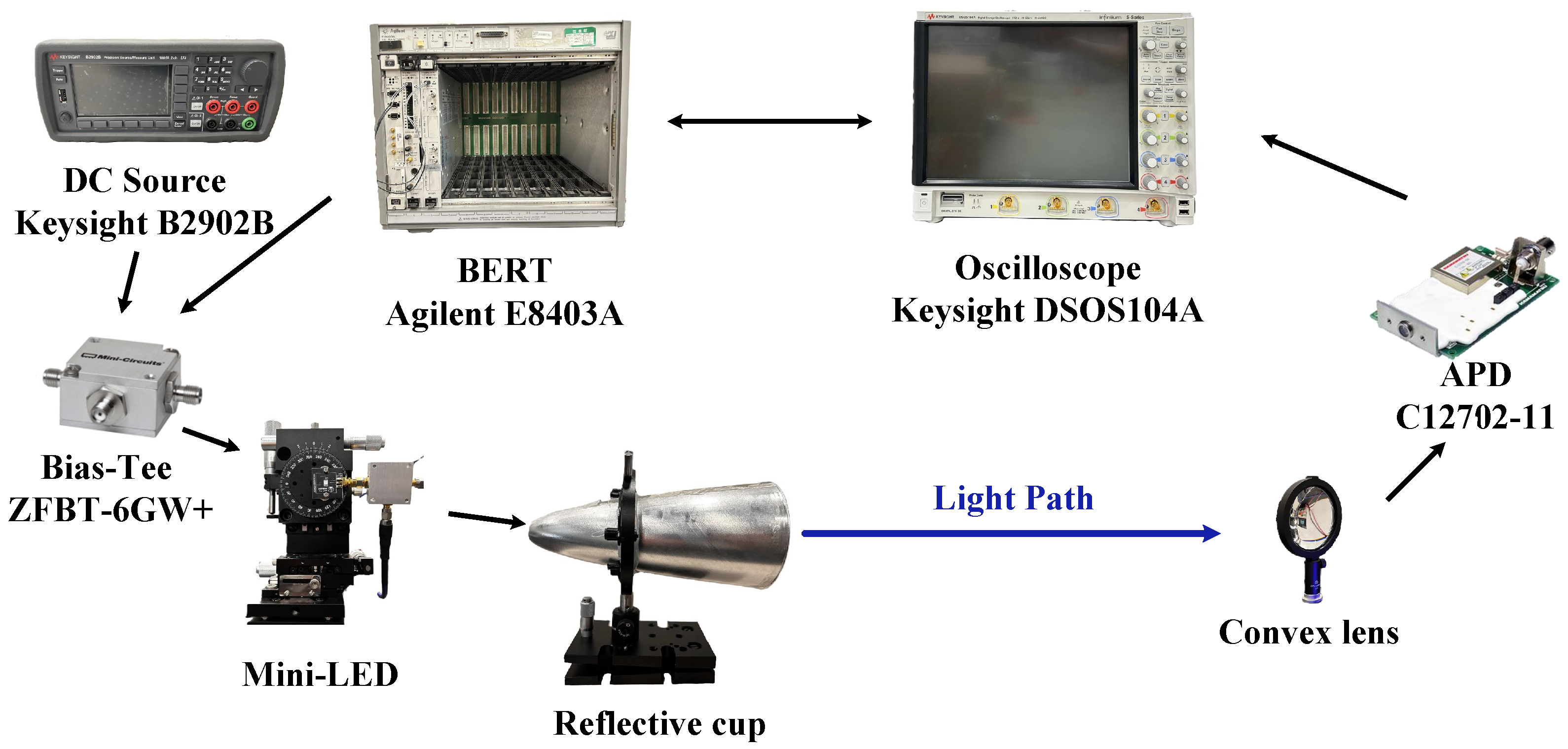


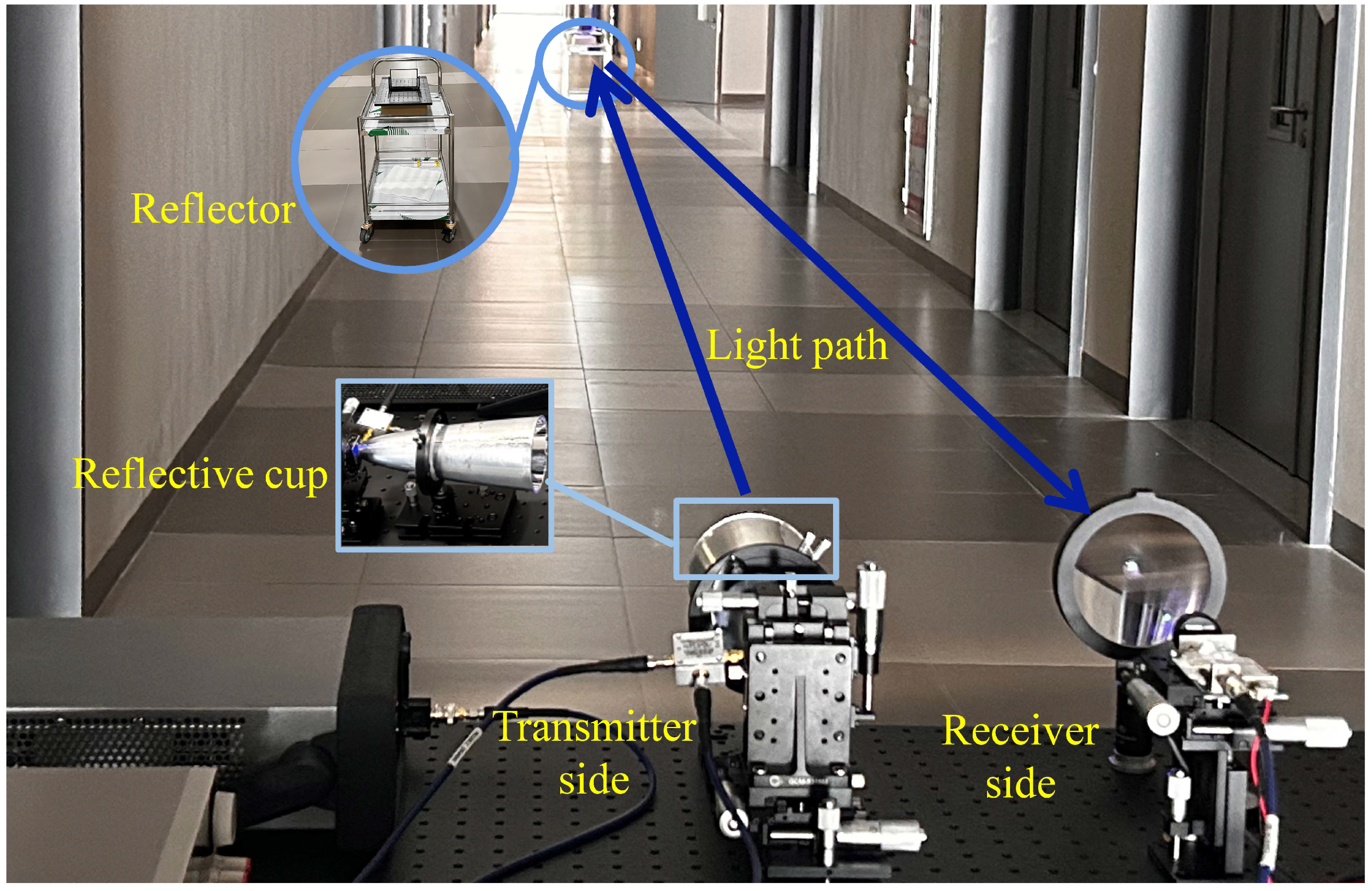
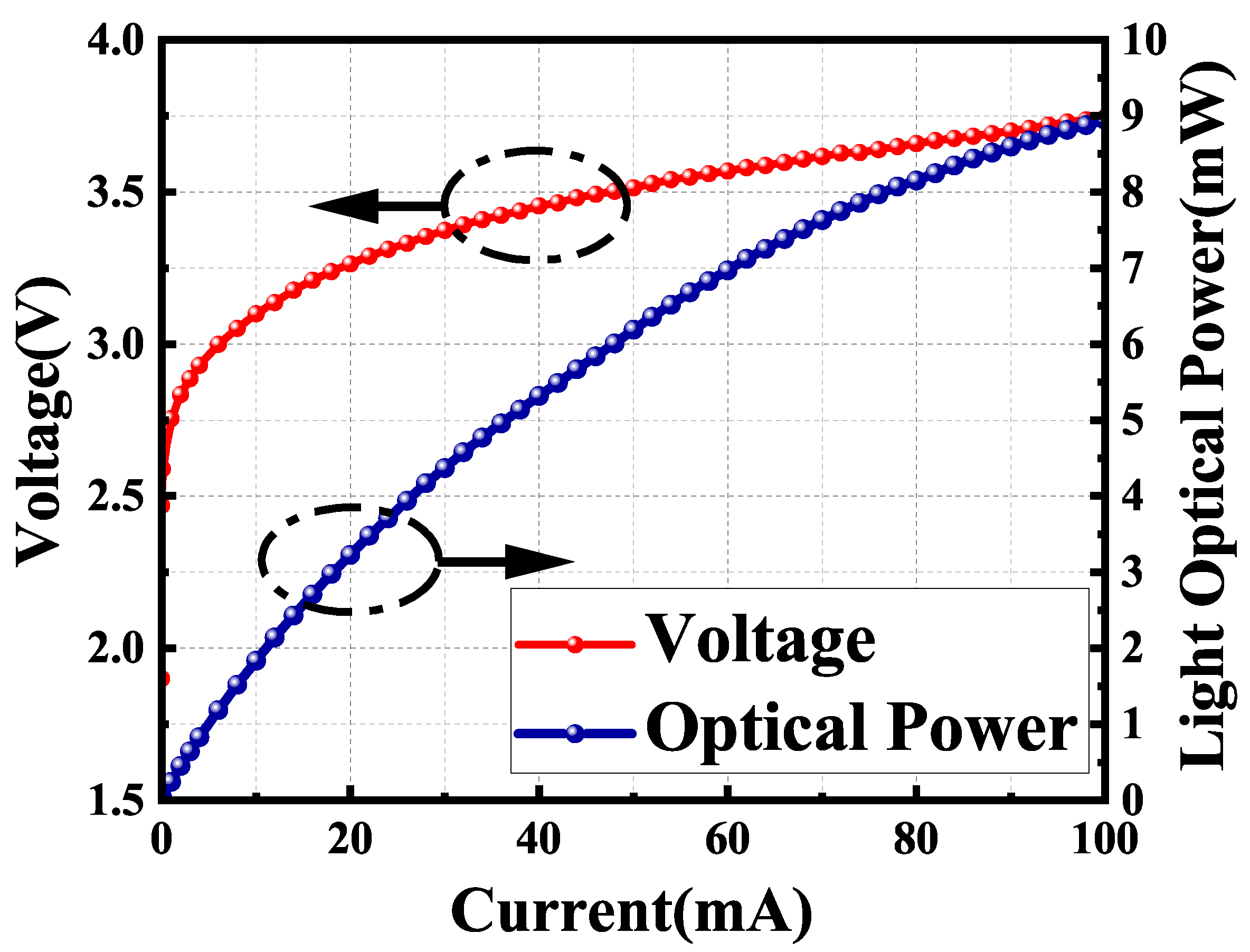

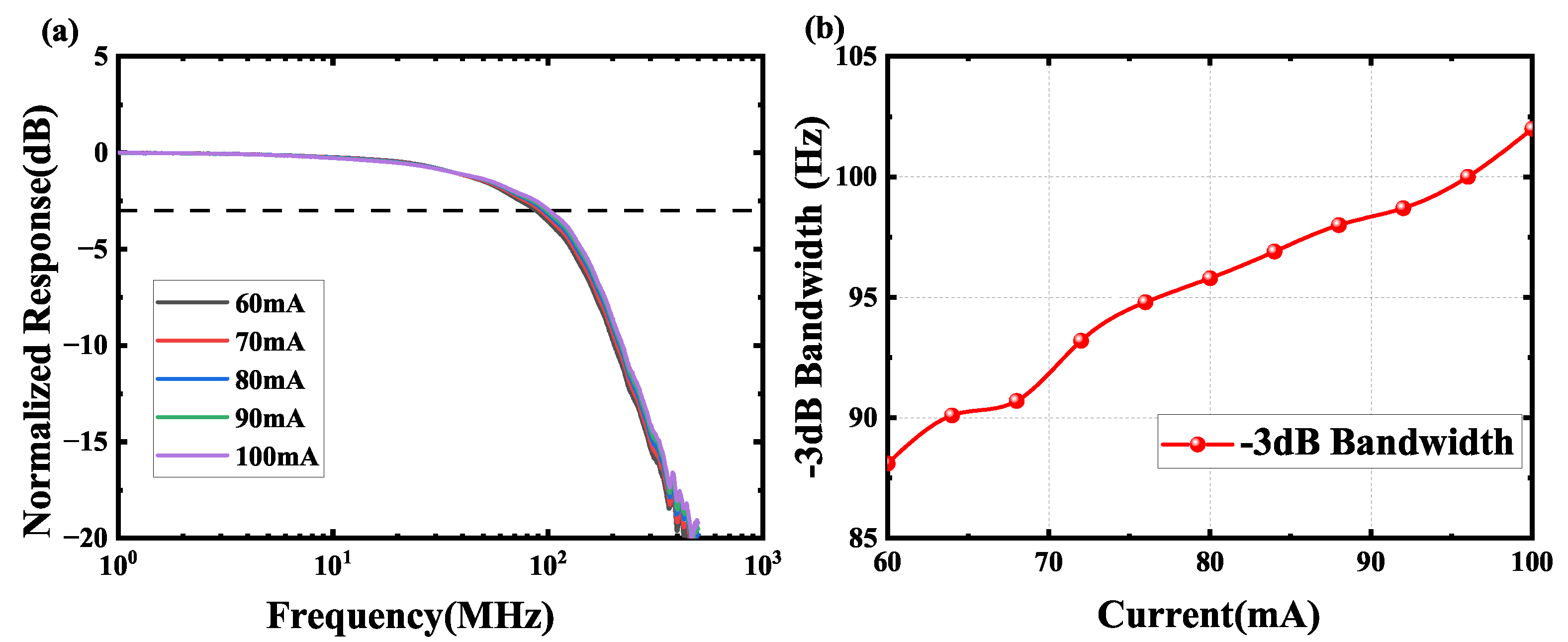

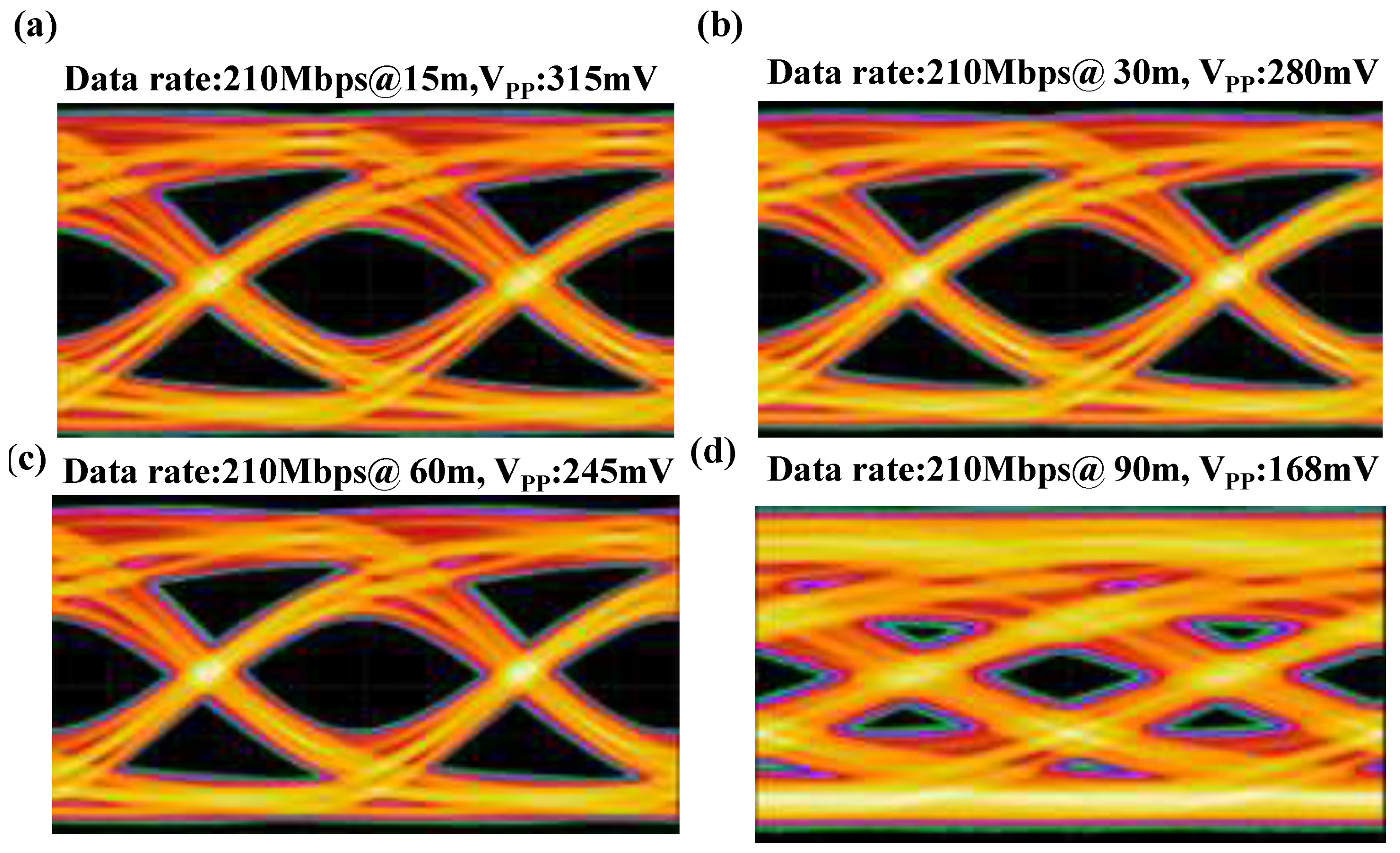

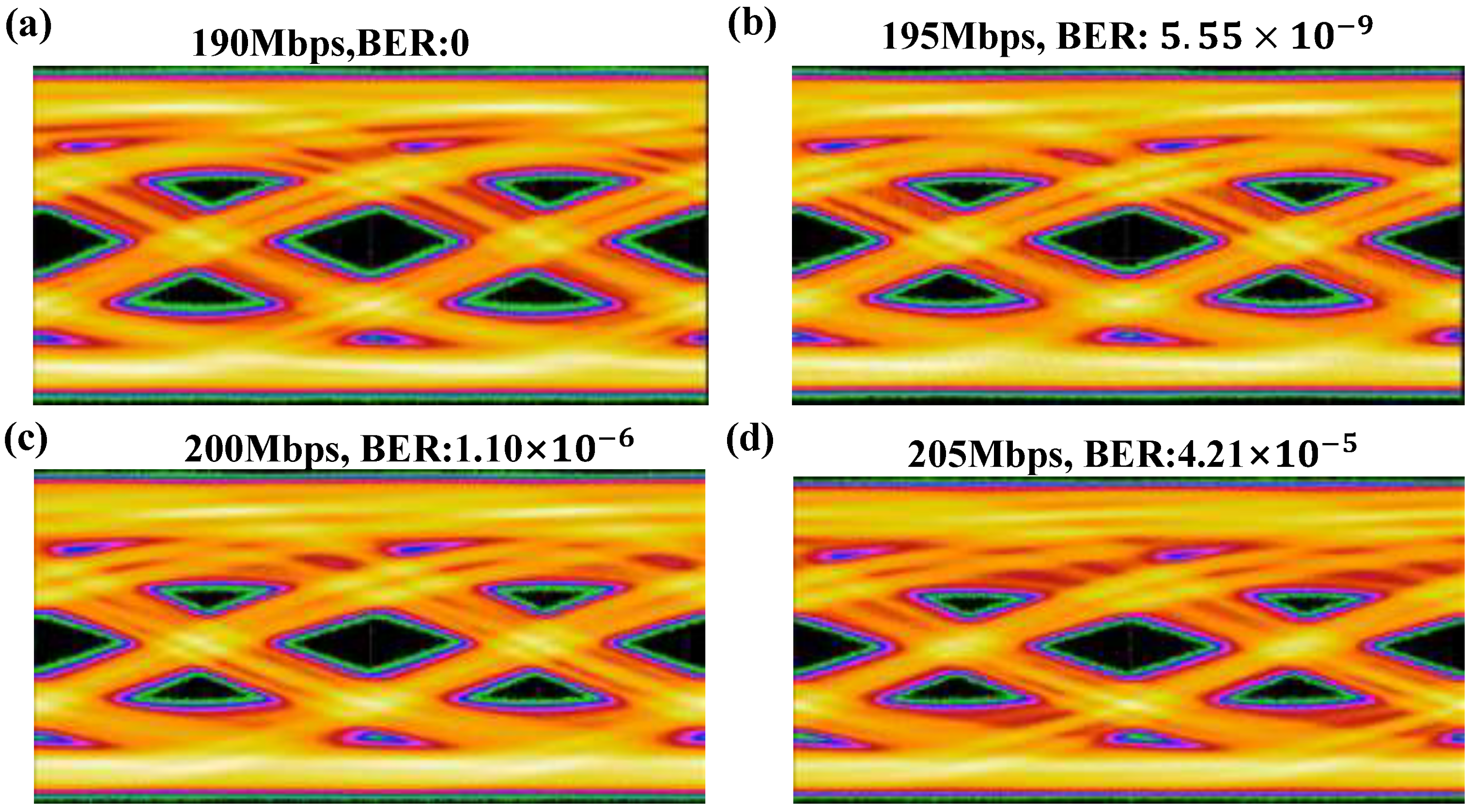
| Group | Type of Light Source | Modulation Scheme | Distance | Channel | Data Rate |
|---|---|---|---|---|---|
| Chao Zhang et al. [16] | Single blue mini-LED | PAM-4 | 2 m | Pure water | 3.8 Gbps |
| Li Xueyang et al. [22] | Single blue mini-LED | PAM-8 | 2 m | Pure water | 5.75 Gbps |
| Ting-Wei Lu et al. [23] | Single blue mini-LED | 16-QAM-OFDM | 1.5 m | Free space | 225 Mbps |
| Zhiqing Zhao et al. [24] | Blue mini-LEDs | MPPM | 1.1 m | Free space | 201.6 kbps |
| Muhammad Hunain Memon et al. [25] | Single blue mini-LED | OOK | ∼m | Pure water | 340 Mbps |
| This work | Single blue mini-LED | NRZ-OOK | >100 m | Free space | 190 Mbps |
Disclaimer/Publisher’s Note: The statements, opinions and data contained in all publications are solely those of the individual author(s) and contributor(s) and not of MDPI and/or the editor(s). MDPI and/or the editor(s) disclaim responsibility for any injury to people or property resulting from any ideas, methods, instructions or products referred to in the content. |
© 2025 by the authors. Licensee MDPI, Basel, Switzerland. This article is an open access article distributed under the terms and conditions of the Creative Commons Attribution (CC BY) license (https://creativecommons.org/licenses/by/4.0/).
Share and Cite
Lv, Z.; Wu, S.; Zhong, J.; Xu, Z.; He, T.; Tian, J.; Zheng, L.; Zhang, H.; Zhang, W.; Nian, M. Beyond 100 m Range Mini-LED-Based Visible Light Communication System. Photonics 2025, 12, 629. https://doi.org/10.3390/photonics12070629
Lv Z, Wu S, Zhong J, Xu Z, He T, Tian J, Zheng L, Zhang H, Zhang W, Nian M. Beyond 100 m Range Mini-LED-Based Visible Light Communication System. Photonics. 2025; 12(7):629. https://doi.org/10.3390/photonics12070629
Chicago/Turabian StyleLv, Zhijian, Shuang Wu, Junye Zhong, Zikun Xu, Tiefeng He, Jinpeng Tian, Linfeng Zheng, Haichuan Zhang, Wenwei Zhang, and Muxin Nian. 2025. "Beyond 100 m Range Mini-LED-Based Visible Light Communication System" Photonics 12, no. 7: 629. https://doi.org/10.3390/photonics12070629
APA StyleLv, Z., Wu, S., Zhong, J., Xu, Z., He, T., Tian, J., Zheng, L., Zhang, H., Zhang, W., & Nian, M. (2025). Beyond 100 m Range Mini-LED-Based Visible Light Communication System. Photonics, 12(7), 629. https://doi.org/10.3390/photonics12070629






